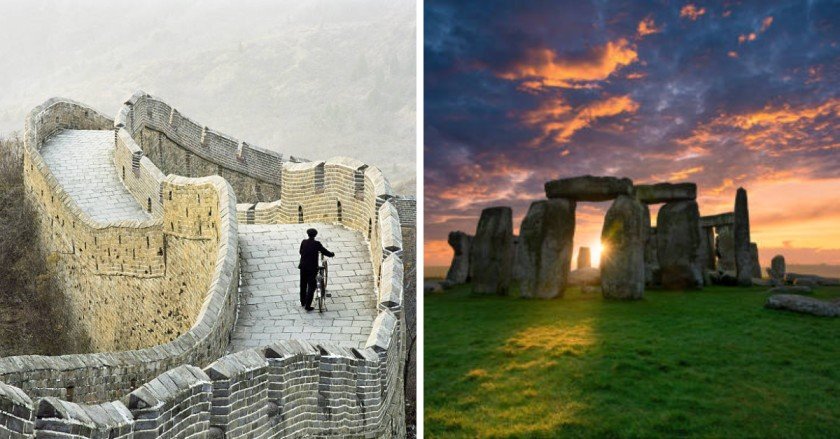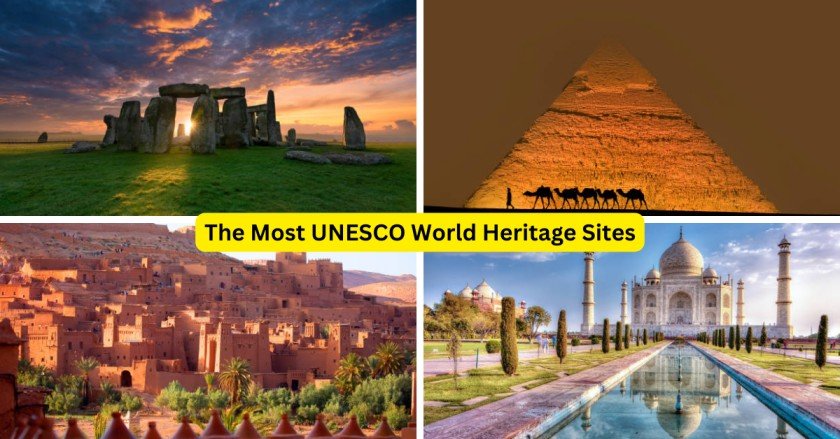Embarking on a captivating global journey to uncover the country with the most UNESCO World Heritage Sites is akin to opening the pages of a vibrant history book, where each site reveals a fascinating chapter of humanity’s diverse and remarkable heritage. Italy, with its illustrious and storied past, takes immense pride in holding this esteemed title, as it offers an awe-inspiring collection of sites that reflect the depth and breadth of its cultural, historical, and artistic tapestry.
From the awe-inspiring architectural marvels of Rome, such as the Colosseum and the Pantheon, to the enchanting and idyllic landscapes of Tuscany, adorned with rolling hills and vineyards, each UNESCO World Heritage Site stands as a testament to Italy’s enduring influence on art, science, and culture throughout the annals of history. Delve deeper into Italy’s enchanting past, and you will discover the ruins of Pompeii, frozen in time by the eruption of Mount Vesuvius, and the majestic canals and palaces of Venice, evoking a sense of timeless beauty and allure.
It is within the hallowed walls of the Vatican City, the seat of the Roman Catholic Church, where one can witness the pinnacle of Renaissance art and architecture, with masterpieces such as Michelangelo’s Sistine Chapel ceiling and St. Peter’s Basilica. The UNESCO World Heritage Sites of Italy are not merely relics of the past but living testaments to the indomitable spirit and creativity of humanity, captivating the hearts and minds of visitors from around the globe.
So, immerse yourself in the captivating charms of Italy’s UNESCO World Heritage Sites, and embark on a journey that will transport you through the ages, allowing you to witness firsthand the profound impact of this extraordinary country on the world’s cultural heritage.
Table of Contents
Introduction to UNESCO World Heritage Sites
UNESCO World Heritage Sites are exceptional landmarks or areas acknowledged and designated by the United Nations Educational, Scientific and Cultural Organization (UNESCO) for their significant cultural, historical, scientific, or other exceptional values. These sites, protected by international treaties, serve as a testament to the shared heritage of humanity and emphasize the importance of preserving and safeguarding our collective legacy for the benefit of present and future generations to come. By recognizing and conserving these extraordinary places, we not only celebrate our diverse cultural heritage but also foster a deeper understanding and appreciation of the richness and diversity of our world’s history and natural wonders.

The Country with the Most UNESCO Sites
Italy proudly claims the crown for the most UNESCO World Heritage Sites, boasting a mesmerizing catalog that spans from the majestic remnants of the mighty Roman Empire, showcasing the architectural marvels and historical significance, to the breathtaking artistic masterpieces of the Renaissance era, captivating the imagination of every visitor. Embarking on a journey through Italy’s extraordinary heritage sites unfolds a timeless exploration of the boundless depths of human creativity and the unparalleled beauty of its natural wonders. With a total of 58 designated sites, Italy stands as a testament to the remarkable achievements, advancements, and contributions of humanity in shaping our world.
List of Italy’s UNESCO World Heritage Sites
- The Historic Centre of Rome and the Properties of the Holy See
- Florence’s Historic Centre
- Venice and its Lagoon
- The Archaeological Area of Agrigento
- The Historic Centre of Naples
- Pisa’s Piazza dei Miracoli
- Vatican City
- The Historic Centre of Siena
- The Historic Centre of the City of Pienza
- The Trulli of Alberobello
- The Early Christian Monuments of Ravenna
- The Historic Centre of San Gimignano
- The City of Verona
- The Royal Palace at Caserta with the Park, the Aqueduct of Vanvitelli, and the San Leucio Complex
- Pompeii, Herculaneum, and Torre Annunziata
- The Costiera Amalfitana
- The Residences of the Royal House of Savoy
- The Cathedral, Torre Civica and Piazza Grande, Modena
- The Archaeological Area and the Patriarchal Basilica of Aquileia
- The Cilento and Vallo di Diano National Park with the Archaeological sites of Paestum and Velia, and the Certosa di Padula
- The Historic Centre of Urbino
- The Portovenere, Cinque Terre, and the Islands (Palmaria, Tino and Tinetto)
- The Villa Romana del Casale
- The Su Nuraxi di Barumini
- The Historical Complex of Split with the Palace of Diocletian
- The Early Christian Monuments of Ravenna
- The City of Verona
- The Etruscan Necropolises of Cerveteri and Tarquinia
- Val d’Orcia
- The Sacri Monti of Piedmont and Lombardy
- The Val d’Orcia
- The Late Baroque Towns of the Val di Noto (South-Eastern Sicily)
- Vicenza and the Palladian Villas of the Veneto
- Ferrara, City of the Renaissance, and its Po Delta
- Castel del Monte
- The Early Christian Monuments of Ravenna
- The Late Baroque Towns of the Val di Noto (South-Eastern Sicily)
- Vicenza and the Palladian Villas of the Veneto
- Ferrara, City of the Renaissance, and its Po Delta
- Castel del Monte
- Archaeological Area and the Patriarchal Basilica of Aquileia
- City of Vicenza and the Palladian Villas of the Veneto
- The Botanical Garden (Orto Botanico), Padua
- The Sassi and the Park of the Rupestrian Churches of Matera
- Su Nuraxi di Barumini
- Chief Towns in Val di Noto (South-Eastern Sicily)
- Medici Villas and Gardens in Tuscany
- Mount Etna
- Syracuse and the Rocky Necropolis of Pantalica
- Genoa: Le Strade Nuove and the system of the Palazzi dei Rolli
- Mantua and Sabbioneta
- Rhaetian Railway in the Albula / Bernina Landscapes
- The Dolomites
- Longobards in Italy, Places of Power (568-774 A.D.)
- Prehistoric Pile dwellings around the Alps
- Etna’s Volcanic Area
- Mount San Giorgio
- Crespi d’Adda
With such an impressive list of UNESCO World Heritage Sites, it is no wonder that Italy remains a top destination for travelers seeking to explore and experience the wonders of human history and natural beauty. From ancient ruins to breathtaking landscapes, from artistic masterpieces to architectural marvels, each site offers a unique glimpse into the depth and diversity of Italian culture, making it an unforgettable journey for all who visit. So next time you plan a trip, consider adding one or more of Italy’s UNESCO World Heritage Sites to your itinerary and discover the magic that lies within these extraordinary places. Be it through art, architecture, history, or nature – there is something for everyone in Italy’s remarkable catalog of cultural and natural treasures.
When visiting Italy’s UNESCO World Heritage Sites, timing, fees, activities, and etiquette are important to plan for the best experience.

Best Time to Visit
To truly enjoy the essence of Italy’s sites without the crowds, one should consider visiting during the shoulder seasons, April to June and September to October. The weather is pleasant for outdoor exploration, and the tourist traffic is relatively low.
Fees
Entry fees for these sites vary. For example, the Colosseum in Rome charges about €16 for a standard ticket. It’s recommended to check official sites or contact local tourism offices for the most accurate pricing as some may offer discounts for students, children, and seniors.
To Do
- Engage with Guided Tours: Many of these locations offer guided tours which can provide enriching historical context.
- Photography: Make sure to capture the incredible beauty of these sites—within the rules of each site, of course.
Not to Do
- Do Not Touch Artifacts: It’s crucial to not touch the historical structures or artifacts to preserve them for future generations.
- Respect Restricted Areas: Always adhere to signs and barriers that designate private or protected areas.
What Else to Keep in Mind
- Plan Ahead: Some popular sites require advance booking, so plan accordingly.
- Respectful Attire: Remember that places like the Vatican have a strict dress code, calling for modest clothing.
- Travel Insurance: It is advisable to have travel insurance to cover any unexpected events.
Each site will have its unique charm and stipulations. It is beneficial to research each destination prior to visiting to make the most of your trip while respecting and maintaining the integrity of these historical treasures.
Why UNESCO Sites Matter
These remarkable sites serve as the steadfast guardians of our collective memory, celebrating the extraordinary achievements of humanity throughout history. They stand tall, reminding us of the urgent need to safeguard these wonders against the relentless passage of time and the ever-encroaching forces of modernity.
Moreover, these sites play a vital role in helping us comprehend our rich and diverse past, enabling us to shape our present identity and future aspirations. They act as magnificent bridges, connecting civilizations across the globe, fostering cultural exchange, and promoting mutual understanding.
Let us cherish and protect these invaluable treasures, for they hold the key to unlocking the profound wisdom and heritage of our shared human experience.

Explore Top UNESCO World Heritage Sites in Each Country
As we embark on our journey, traversing the vibrant cities of Italy, we are captivated by the bustling streets, the aroma of freshly brewed espresso, and the intricate architecture that tells stories of a rich history.
Continuing our adventure, we find ourselves immersed in the tranquil landscapes of China’s Wulingyuan Scenic Area. Towering sandstone pillars, adorned with lush greenery, create a breathtaking backdrop that transports us to a world of sublime beauty.
Our exploration takes us further, to the enchanting Loire Valley in France, where fairytale-like castles dot the picturesque countryside. Each castle whispers tales of ancient nobility and grandeur, inviting us to step back in time and imagine the lives of kings and queens.
Beyond these remarkable destinations, we continue to unravel the tapestry of sites that make each country unique. From the bustling cities to the serene landscapes, from the tales of emperors and artists to the silent sagas of natural wonders, we are reminded of the rich diversity and captivating stories that await us in every corner of the world.
Protecting Our Heritage for the Future
The preservation of these sites goes beyond mere admiration; it is a profound responsibility that we bear. As stewards of these cultural gems, it is our duty to ensure that they remain untouched, safeguarding them for future generations to cherish, appreciate, and learn from. It is not solely about conserving the past; it is about enriching the future, allowing the stories and significance of these sites to continue to inspire and shape our collective journey through time.
Conclusion: The Importance of Worldwide Heritage Preservation
In conclusion, Italy’s unparalleled compilation of UNESCO World Heritage Sites serves as a beacon of the cultural wealth that countries around the world strive to celebrate and conserve. This legacy is a treasure trove for humanity, a collective heirloom that underscores the importance of preservation and the celebration of our global heritage.
With its rich history and diverse landscapes, Italy offers a captivating journey through time. From the ancient ruins of Rome to the breathtaking canals of Venice, every corner of the country tells a story of its past. The architectural marvels, such as the Colosseum and the Leaning Tower of Pisa, stand as testaments to human ingenuity and craftsmanship.
Furthermore, Italy’s UNESCO World Heritage Sites encompass a wide range of cultural and natural wonders. From the picturesque Amalfi Coast to the majestic Dolomites, these sites showcase the country’s stunning beauty and unique biodiversity. Each site has its own distinct charm and significance, representing different periods of history and reflecting the diverse influences that have shaped Italy’s identity.
Visiting these sites not only offers an opportunity to immerse oneself in the beauty of Italy but also provides a deeper understanding of the country’s rich cultural heritage. It is a chance to appreciate the art, architecture, and traditions that have been passed down through generations, and to witness the legacy that Italy has contributed to the world.
In essence, Italy’s UNESCO World Heritage Sites are not just monuments or landmarks, but living testaments to the creativity and resilience of human civilization. They remind us of our shared history and the importance of preserving our cultural treasures for future generations. Italy’s commitment to safeguarding these sites sets an example for the rest of the world, inspiring us all to cherish and protect the global heritage that unites us.
Frequently Asked Questions (FAQs)
Which country has the highest number of UNESCO World Heritage Sites?
Italy proudly claims the esteemed honor of having the highest number of UNESCO World Heritage Sites, a remarkable count of 58 sites that span across its diverse and captivating regions. This impressive number not only attests to Italy’s extraordinary wealth of art, history, and natural wonders but also showcases the profound tapestry that weaves together its cultural heritage. Each of these cherished sites offers a gateway to the past, inviting visitors to explore and immerse themselves in Italy’s rich cultural traditions and its significant contributions to the history of human civilization. From the awe-inspiring ancient ruins to the breathtaking landscapes, Italy’s UNESCO World Heritage Sites are a testament to the enduring legacy that continues to inspire and captivate the world.
Which country is home to the most UNESCO World Heritage Sites?
As of the latest updates, Italy proudly stands at the forefront, boasting the highest number of UNESCO World Heritage Sites. From the beautifully preserved archaeological areas of Pompeii, which offer a captivating glimpse into ancient Roman civilization, to the breathtaking vineyard landscape of Piedmont, where rolling hills adorned with grapevines create a picturesque setting, Italy’s diverse collection of cultural and natural heritage sites reflects its rich historical significance and unrivaled natural diversity. Each site tells a unique story, transporting visitors through time and immersing them in the country’s remarkable past and present. Whether exploring the stunning art and architecture of Florence, marveling at the grandeur of the Colosseum in Rome, or basking in the enchanting beauty of the Amalfi Coast, Italy’s World Heritage Sites provide an unforgettable journey into the heart and soul of this extraordinary country.
Which city has the most UNESCO World Heritage Sites?
Rome, famously known as the “Eternal City,” stands as a testament to its rich history, captivating architecture, and artistic treasures. With an abundance of UNESCO World Heritage Sites nestled within its boundaries, Rome unveils an awe-inspiring cultural landscape that leaves visitors in awe.
At the heart of the city lies the historic centre of Rome, a living testimony to centuries of human achievement and civilization. From the imposing ruins of the Colosseum, where gladiators once battled, to the iconic Pantheon, an architectural marvel that has withstood the test of time, each stone tells a story of ancient grandeur.
Beyond the historic centre, Rome also houses the properties of the Holy See, the spiritual hub of the Roman Catholic Church. A visit to the Vatican City reveals a divine fusion of faith, art, and history. Marvel at the masterpiece of Michelangelo’s Sistine Chapel, where the ceiling comes alive with biblical scenes, or gaze in wonder at the grandeur of St. Peter’s Basilica, the largest church in the world.
Venturing further, one encounters the Basilica of Saint Paul Outside the Walls, a majestic basilica that houses the tomb of Saint Paul. Here, visitors can immerse themselves in the spiritual tranquility and architectural splendor that echoes throughout the centuries.
With its abundance of UNESCO World Heritage Sites, Rome is a treasure trove of cultural wonders that beckon exploration. Immerse yourself in the captivating allure of its history, architecture, and art, and discover the timeless charm of the “Eternal City.”
Which country is home to seven UNESCO World Heritage Sites?
Portugal, with its rich historical roots and abundant cultural landmarks, boasts an impressive collection of seven UNESCO World Heritage Sites. These sites encompass a diverse range of treasures, from the awe-inspiring architectural marvels of the Monastery of Batalha to the breathtaking landscapes of the Natural Park of Pico Island Vineyard Culture in the Azores. Each site tells a unique story, showcasing Portugal’s unwavering commitment to safeguarding and celebrating its extraordinary historical and natural legacies. Explore these remarkable sites and immerse yourself in the captivating tapestry of Portugal’s past and present.
How many UNESCO World Heritage Sites are there in India?
India, a land of rich cultural and natural heritage, proudly boasts an impressive collection of 40 UNESCO World Heritage Sites. These sites offer a glimpse into the diverse tapestry of India’s history and showcase its architectural marvels, like the iconic Taj Mahal, a testament to eternal love. The cultural landscapes, such as the Khajuraho Group of Monuments, capture the artistic brilliance and intricate carvings of ancient temples. Additionally, India’s natural wonders, like the majestic Western Ghats, mesmerize with their lush greenery and breathtaking landscapes. Each of these sites tells a unique story and invites visitors to immerse themselves in the remarkable heritage of this incredible country.
How many UNESCO World Heritage Sites are there in the world?
As of 31 January 2024, there are 1,154 UNESCO World Heritage Sites spread across 167 countries. These remarkable sites, carefully selected for their outstanding universal value, showcase the richness and diversity of our cultural, historical, scientific, and natural heritage. From ancient archaeological wonders to breathtaking natural landscapes, each site holds a unique story and contributes to our collective human legacy. These exceptional sites are not only recognized for their significance but are also legally protected by international treaties, ensuring their preservation for future generations to appreciate and learn from. Let us cherish and celebrate the invaluable heritage of humanity that these UNESCO World Heritage Sites represent.
Which UNESCO World Heritage Site is the most recent addition?
The most recent additions to the UNESCO World Heritage List, which recognizes and preserves cultural and natural sites of outstanding universal value, are frequently unveiled during the annual sessions of the esteemed World Heritage Committee. If you’re eager to stay informed about the latest captivating World Heritage Sites from around the globe, we highly recommend visiting the official UNESCO World Heritage Centre website, where you can find comprehensive and up-to-date information.
Remember, visiting UNESCO World Heritage Sites is not only a travel adventure but also a journey through time, offering deep insights into human history and natural history. It’s our global duty to respect and conserve these treasures for present and future generations to enjoy and learn from.
Read Related Article on Travel:-
Discover the Top 10 Tourist Attractions in New Zealand You Can’t Miss in 2024
New Zealand offers abundant remarkable destinations for 2024. Top attractions include the majestic Milford Sound fjord with towering cliffs and waterfalls; Auckland’s Sky Tower with panoramic city views and thrilling activities; the vivid Hobbiton Movie Set bringing Middle Earth to life; Rotorua’s geothermal wonders and Maori cultural experiences; Queenstown’s adventure sports amidst alpine scenery; Aoraki/Mount Cook National Park’s towering peaks and stargazing; the magical glowworm-illuminated Waitomo Caves; Wellington’s Te Papa museum showcasing New Zealand’s nature and heritage; Abel Tasman National Park’s golden beaches and coastal paradise; and Dunedin’s Scottish-inspired architecture blended with Otago Peninsula’s rare wildlife. With breathtaking landscapes, indigenous culture, and heart-pumping adventures, New Zealand guarantees unforgettable memories. Visitors are invited to delve into extraordinary beauty and diverse offerings as they explore these remarkable must-see destinations….Read More
 Skip to content
Skip to content












